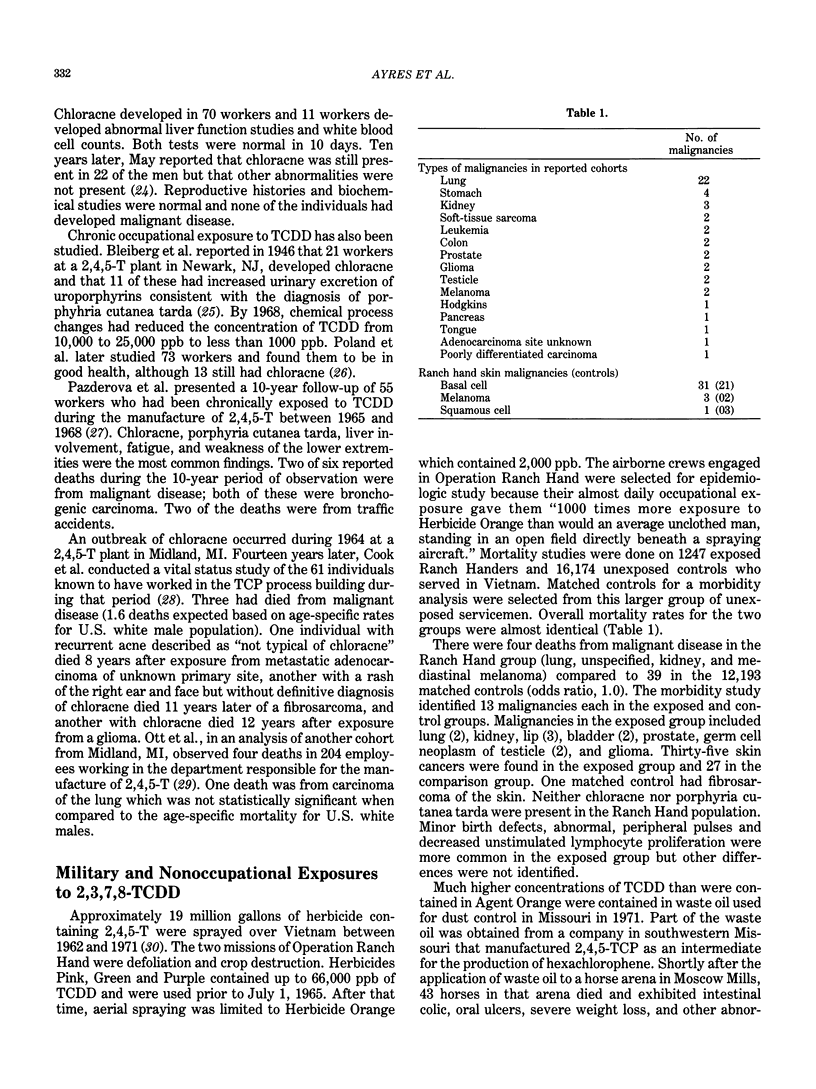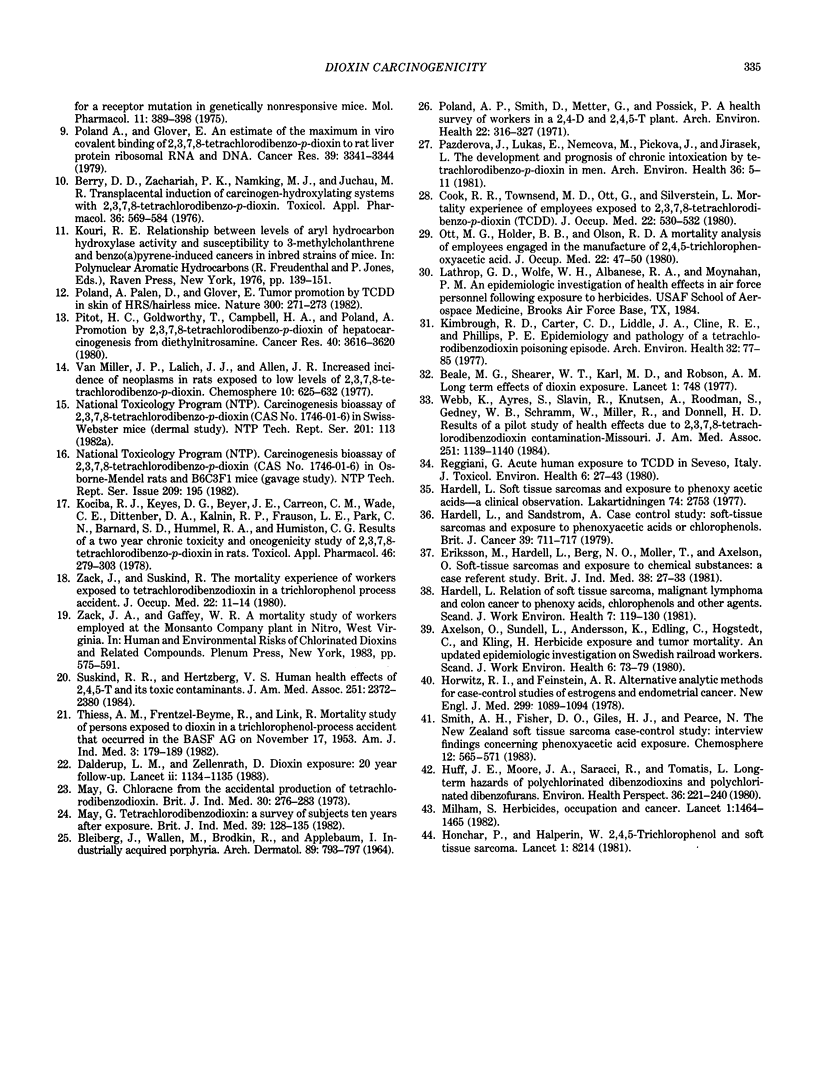Abstract
2,3,7,8-Tetrachlorodibenzo-p-dioxin (TCDD) has suddenly become the focal point of controversy over the relationship of chemical waste to human health. Specific concern exists regarding its potential association with human malignancy. Subcellular, cellular, and whole-animal experiments suggest that TCDD exerts much of its activity by inducing enzymes that protect the intact organism from the assault of environmental contamination. TCDD is a potent inducer of aryl hydrocarbon hydroxylase, although wide variations between species do exist. Conventional tests for mutagenicity have produced conflicting results. Animal experiments have shown the development of tumors following chronic low level ingestion of TCDD. The human evidence regarding the potential carcinogencity of TCDD comes from occupational, military and environmental exposures. Several studies have come out of Sweden suggesting an association between sarcoma and exposure to herbicides. Although there is little solid evidence that 2,3,7,8-TCDD produces substantial chronic disability or premature death in man, a significant body of experimental evidence for its carcinogenicity makes it likely that a small number of human malignancies may be due to its action. Since 2,3,7,8-TCDD is an unwanted contaminant it could be eliminated with little measurable consequence.
Full text
PDF






Selected References
These references are in PubMed. This may not be the complete list of references from this article.
- Axelson O., Sundell L., Andersson K., Edling C., Hogstedt C., Kling H. Herbicide exposure and tumor mortality. An updated epidemiologic investigation on Swedish railroad workers. Scand J Work Environ Health. 1980 Mar;6(1):73–79. doi: 10.5271/sjweh.2631. [DOI] [PubMed] [Google Scholar]
- BLEIBERG J., WALLEN M., BRODKIN R., APPLEBAUM I. L. INDUSTRIALLY ACQUIRED PORPHYRIA. Arch Dermatol. 1964 Jun;89:793–797. doi: 10.1001/archderm.1964.01590300021006. [DOI] [PubMed] [Google Scholar]
- Beale M. G., Shearer W. T., Karl M. M., Robson A. M. Long-term effects of dioxin exposure. Lancet. 1977 Apr 2;1(8014):748–748. doi: 10.1016/s0140-6736(77)92188-2. [DOI] [PubMed] [Google Scholar]
- Berry D. L., Zachariah P. K., Namkung M. J., Juchau M. R. Transplacental induction of carcinogen-hydroxylating systems with 2,3,7,8-tetrachlorodibenzo-p-dioxin. Toxicol Appl Pharmacol. 1976 Jun;36(3):569–584. doi: 10.1016/0041-008x(76)90236-2. [DOI] [PubMed] [Google Scholar]
- Cook R. R., Townsend J. C., Ott M. G., Silverstein L. G. Mortality experience of employees exposed to 2,3,7,8-tetrachlorodibenzo-p-dioxin (TCDD). J Occup Med. 1980 Aug;22(8):530–532. doi: 10.1097/00043764-198008000-00009. [DOI] [PubMed] [Google Scholar]
- Courtney K. D., Moore J. A. Teratology studies with 2,4,5-trichlorophenoxyacetic acid and 2,3,7,8-tetrachlorodibenzo-p-dioxin. Toxicol Appl Pharmacol. 1971 Nov;20(3):396–403. doi: 10.1016/0041-008x(71)90282-1. [DOI] [PubMed] [Google Scholar]
- Dalderup L. M., Zellenrath D. Dioxin exposure: 20 year follow-up. Lancet. 1983 Nov 12;2(8359):1134–1135. doi: 10.1016/s0140-6736(83)90641-4. [DOI] [PubMed] [Google Scholar]
- Eriksson M., Hardell L., Berg N. O., Möller T., Axelson O. Soft-tissue sarcomas and exposure to chemical substances: a case-referent study. Br J Ind Med. 1981 Feb;38(1):27–33. doi: 10.1136/oem.38.1.27. [DOI] [PMC free article] [PubMed] [Google Scholar]
- Goldstein J. A. The structure-activity relationships of halogenated biphenyls as enzyme inducers. Ann N Y Acad Sci. 1979 May 31;320:164–178. [PubMed] [Google Scholar]
- Hardell L. Maligna mesenkymala tumörer och exposition för fenoxisyror -- en klinisk observation. Lakartidningen. 1977 Aug 17;74(33):2753–2754. [PubMed] [Google Scholar]
- Hardell L. Relation of soft-tissue sarcoma, malignant lymphoma and colon cancer to phenoxy acids, chlorophenols and other agents. Scand J Work Environ Health. 1981 Jun;7(2):119–130. doi: 10.5271/sjweh.2557. [DOI] [PubMed] [Google Scholar]
- Hardell L., Sandström A. Case-control study: soft-tissue sarcomas and exposure to phenoxyacetic acids or chlorophenols. Br J Cancer. 1979 Jun;39(6):711–717. doi: 10.1038/bjc.1979.125. [DOI] [PMC free article] [PubMed] [Google Scholar]
- Holmstedt B. Prolegomena to Seveso. Ecclesiastes I 18. Arch Toxicol. 1980 Apr;44(4):211–230. doi: 10.1007/BF00278030. [DOI] [PubMed] [Google Scholar]
- Horwitz R. I., Feinstein A. R. Alternative analytic methods for case-control studies of estrogens and endometrial cancer. N Engl J Med. 1978 Nov 16;299(20):1089–1094. doi: 10.1056/NEJM197811162992001. [DOI] [PubMed] [Google Scholar]
- Huff J. E., Moore J. A., Saracci R., Tomatis L. Long-term hazards of polychlorinated dibenzodioxins and polychlorinated dibenzofurans. Environ Health Perspect. 1980 Jun;36:221–240. doi: 10.1289/ehp.8036221. [DOI] [PMC free article] [PubMed] [Google Scholar]
- Kimbrough R. D., Carter C. D., Liddle J. A., Cline R. E. Epidemiology and pathology of a tetrachlorodibenzodioxin poisoning episode. Arch Environ Health. 1977 Mar-Apr;32(2):77–86. doi: 10.1080/00039896.1977.10667259. [DOI] [PubMed] [Google Scholar]
- Kociba R. J., Keyes D. G., Beyer J. E., Carreon R. M., Wade C. E., Dittenber D. A., Kalnins R. P., Frauson L. E., Park C. N., Barnard S. D. Results of a two-year chronic toxicity and oncogenicity study of 2,3,7,8-tetrachlorodibenzo-p-dioxin in rats. Toxicol Appl Pharmacol. 1978 Nov;46(2):279–303. doi: 10.1016/0041-008x(78)90075-3. [DOI] [PubMed] [Google Scholar]
- Kociba R. J., Schwetz B. A. Toxicity of 2, 3, 7, 8-tetrachlorodibenzo-p-dioxin (TCDD). Drug Metab Rev. 1982;13(3):387–406. doi: 10.3109/03602538209029986. [DOI] [PubMed] [Google Scholar]
- May G. Chloracne from the accidental production of tetrachlorodibenzodioxin. Br J Ind Med. 1973 Jul;30(3):276–283. doi: 10.1136/oem.30.3.276. [DOI] [PMC free article] [PubMed] [Google Scholar]
- May G. Tetrachlorodibenzodioxin: a survey of subjects ten years after exposure. Br J Ind Med. 1982 May;39(2):128–135. doi: 10.1136/oem.39.2.128. [DOI] [PMC free article] [PubMed] [Google Scholar]
- McConnell E. E., Moore J. A., Dalgard D. W. Toxicity of 2,3,7,8-tetrachlorodibenzo-p-dioxin in rhesus monkeys (Macaca mulatta) following a single oral dose. Toxicol Appl Pharmacol. 1978 Jan;43(1):175–187. doi: 10.1016/s0041-008x(78)80042-8. [DOI] [PubMed] [Google Scholar]
- McConnell E. E., Moore J. A., Haseman J. K., Harris M. W. The comparative toxicity of chlorinated dibenzo-p-dioxins in mice and guinea pigs. Toxicol Appl Pharmacol. 1978 May;44(2):335–356. doi: 10.1016/0041-008x(78)90195-3. [DOI] [PubMed] [Google Scholar]
- Milham S., Jr Herbicides, occupation, and cancer. Lancet. 1982 Jun 26;1(8287):1464–1465. doi: 10.1016/s0140-6736(82)92470-9. [DOI] [PubMed] [Google Scholar]
- Ott M. G., Holder B. B., Olson R. D. A mortality analysis of employees engaged in the manufacture of 2,4,5-trichlorophenoxyacetic acid. J Occup Med. 1980 Jan;22(1):47–50. [PubMed] [Google Scholar]
- Pazderova-Vejlupková J., Lukás E., Nemcova M., Pícková J., Jirásek L. The development and prognosis of chronic intoxication by tetrachlordibenzo-p-dioxin in men. Arch Environ Health. 1981 Jan-Feb;36(1):5–11. doi: 10.1080/00039896.1981.10667598. [DOI] [PubMed] [Google Scholar]
- Pitot H. C., Goldsworthy T., Campbell H. A., Poland A. Quantitative evaluation of the promotion by 2,3,7,8-tetrachlorodibenzo-p-dioxin of hepatocarcinogenesis from diethylnitrosamine. Cancer Res. 1980 Oct;40(10):3616–3620. [PubMed] [Google Scholar]
- Poland A. P., Smith D., Metter G., Possick P. A health survey of workers in a 2,4-D and 2,4,5-T plan with special attention to chloracne, porphyria cutanea tarda, and psychologic parameters. Arch Environ Health. 1971 Mar;22(3):316–327. doi: 10.1080/00039896.1971.10665850. [DOI] [PubMed] [Google Scholar]
- Poland A., Glover E. An estimate of the maximum in vivo covalent binding of 2,3,7,8-tetrachlorodibenzo-p-dioxin to rat liver protein, ribosomal RNA, and DNA. Cancer Res. 1979 Sep;39(9):3341–3344. [PubMed] [Google Scholar]
- Poland A., Greenlee W. F., Kende A. S. Studies on the mechanism of action of the chlorinated dibenzo-p-dioxins and related compounds. Ann N Y Acad Sci. 1979 May 31;320:214–230. doi: 10.1111/j.1749-6632.1979.tb56603.x. [DOI] [PubMed] [Google Scholar]
- Poland A., Palen D., Glover E. Tumour promotion by TCDD in skin of HRS/J hairless mice. Nature. 1982 Nov 18;300(5889):271–273. doi: 10.1038/300271a0. [DOI] [PubMed] [Google Scholar]
- Reggiani G. Acute human exposure to TCDD in Seveso, Italy. J Toxicol Environ Health. 1980 Jan;6(1):27–43. doi: 10.1080/15287398009529828. [DOI] [PubMed] [Google Scholar]
- Suskind R. R., Hertzberg V. S. Human health effects of 2,4,5-T and its toxic contaminants. JAMA. 1984 May 11;251(18):2372–2380. [PubMed] [Google Scholar]
- Thiess A. M., Frentzel-Beyme R., Link R. Mortality study of persons exposed to dioxin in a trichlorophenol-process accident that occurred in the BASF AG on November 17, 1953. Am J Ind Med. 1982;3(2):179–189. doi: 10.1002/ajim.4700030209. [DOI] [PubMed] [Google Scholar]
- Zack J. A., Suskind R. R. The mortality experience of workers exposed to tetrachlorodibenzodioxin in a trichlorophenol process accident. J Occup Med. 1980 Jan;22(1):11–14. [PubMed] [Google Scholar]


